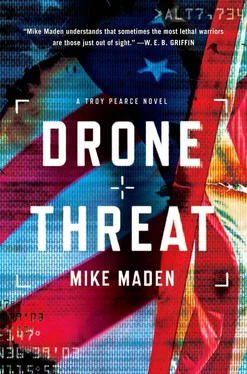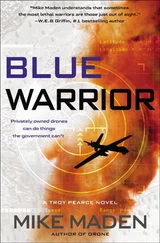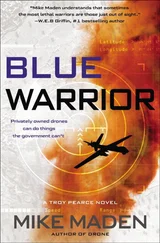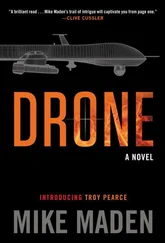“Only once, briefly, at an embassy function. She was also in the meeting I attended yesterday.” Al-Saud reflected for a moment. Smiled. “A beautiful woman.”
“She’s quite brilliant, actually. And very well connected with senior defense leadership on Capitol Hill. She would also be in favor of selling drones to your country, as would the American corporations that make them. You should try and meet her again.”
“An excellent idea.”
“But even if you got your drones, that won’t be enough to stop ISIS or the Iranians. You still need vast numbers of combat troops to defend your interests. We stand prepared to do so. Our own interests are at stake in the region also, including Iraq. Events could force us to act unilaterally. However, it would be better if we were invited in.”
“By us?”
“Of course. But by the Americans, too. The symbolism would be important to the world. And to us.”
Al-Saud leaned forward and poured more coffee for Tarkovsky. “You mean, the sanctions. As in, lifting them.”
“Those as well.”
Al-Saud set the pot back down, thinking. “So where are we, exactly? Where are our mutual interests?”
“I have some influence with Ms. Grafton as well as a few other resources. I will press your case for American drone sales as well as for an American commitment to dismantle and destroy the Daesh Caliphate. If the Americans are unwilling to do so, my government will. And if the Americans refuse to sell you their drone systems, I can safely say that my government stands ready to provide them.”
“All of this is quite generous. What is it that you want from me in return?”
“Perhaps you can use your influence to convince the Americans to lift their sanctions against us and to invite us into the war against ISIS.”
“In effect, you’re asking us to change dance partners in the middle of a dance.”
“Only because the other partner won’t dance to your tune. If the Americans won’t exercise leadership in the region, we will partner with you and the other Sunni governments to protect Sunni interests. But we’re more than willing to partner with the Americans as well. In fact, we prefer it. Shared responsibility is in all of our best interests.”
“Why do you suppose President Lane can’t see that?”
Tarkovsky sighed. “It’s a legacy from his political mentor, Margaret Myers.”
“Is Myers still playing a role in his administration?”
“It’s unclear. However, Troy Pearce is one of Lane’s closest advisors. I suspect he is the biggest problem you need to deal with.”
“Yes, I met him yesterday as well. A quite unpleasant fellow.”
“Former CIA special forces. Very dangerous. And smart. The CEO of his own security company, specializing in drone operations.”
“Any suggestions about how we might deal with him?”
Tarkovsky set his cup down and leaned forward. “Yes, as a matter of fact.”
* * *
The brightly colored monarch butterfly stood on the lip of the chimney just above the room where the two ambassadors were meeting. Its polycarbonate wings gently flapped, keeping the piezoelectric nanogenerators powering its onboard microphone and the rest of the unit. The Israeli engineers who built the audio surveillance device had done a brilliant job of biomimicry.
Perhaps too brilliant.
A brick-red American robin perched in a nearby elm spied the butterfly drone. It swooped in and snatched up the mechanical monarch in its yellow beak before the Israelis knew what happened and, worse, before the conversation down below had ended.
TEXARKANA, TEXAS
Kan-Tex was one of the largest independent trucking firms in the United States. It owned and operated a vast fleet of tanker trucks that hauled oil, gasoline, aviation fuel, and other liquid petrochemicals across the entire contiguous United States. It had a number of federal and state contracts, but its primary business was civilian commercial long hauls for refineries and distributors.
When Maria Mejias joined the company twenty-four years earlier, she thought she would spend her entire work life in a cramped, single-wide office trailer, trapped behind an IBM Selectric typewriter filling out dispatches for her boss, Jimmy Haygood, a semi-literate trucker turned businessman. But her boss turned out to be a business genius, building a national trucking empire through the ruthless acquisition of less efficient trucking firms. He also managed to increase his own operating efficiencies through the use of automation, which came relatively late to the trucking industry. Jimmy was famously loyal and generous with his employees, offering great benefits and profit-sharing opportunities. Maria took advantage of his generosity and completed her online bachelor’s degree in management information systems. An online pop-up ad during one of those courses led her to contact a San Diego company specializing in automated dispatching systems.
Maria introduced the San Diego company to Jimmy and he instantly understood the system’s potential. His company had lost a $56 million lawsuit for a fiery school bus wreck caused by a Kan-Tex driver falling asleep at the wheel. Fortunately, Jimmy’s insurance covered the jury award, but his new insurance premiums threatened to eat up his profits along with the sky-high fuel costs he was experiencing at the time. He was desperate for answers, and Maria’s contact in San Diego delivered them on a digital silver platter.
Just two years later, Maria was on the top floor of a brand-new office building, supervising twenty dispatchers sitting at automated terminals. Each workstation monitored up to thirty tanker trucks at a time. It was a real game changer for Kan-Tex. Not only did the new automated dispatching system track every single vehicle through GPS and provide real-time locations, it coordinated delivery routes, driver schedules, and even maintenance programs. Every aspect of the truck’s mechanics was under automated sensor surveillance. Kan-Tex was able to minimize fuel and maintenance costs because the automated system indicated truck speed, fuel efficiency, engine wear, brake usage, and transmission performance.
But driver safety was paramount in Jimmy’s mind, partly because the vast majority of all truck wrecks were caused by driver error. Automated braking systems and automated remote throttle control were installed to prevent drivers from driving too fast or recklessly. Not only did this save expensive fuel, it saved lives and greatly reduced the company’s insurance costs. Mounted dash and rear cameras also broadcast real-time traffic video, giving dispatchers a live-action view of road conditions. The truck cabs even incorporated a driver fatigue monitoring system through eye tracking and blinking analysis. When the computer algorithms indicated a driver was overly fatigued, the dispatcher would be alerted and, if necessary, could take remote control of the truck and drive it from the workstation to get it off the road. It was similar to the Uninterruptible Autopilot system Boeing patented in 2006 to remotely seize control of hijacked aircraft.
In order for the system to work across the nation, every truck was connected by satellite link to the Kan-Tex dispatch center. But the entire computer system was serviced, maintained, and repaired remotely from the computer company’s headquarters in San Diego.
Maria had just finished her cigarette break when she sat down at her desk at noon. Her master monitor was networked into the other dispatching monitors. This allowed her to remotely supervise each dispatcher as well as select any of the 582 vehicles on the road they were all tracking today. She opened up her current favorite romance novel and dived back into the read, but ten minutes later a gentle alarm bell signaled that the entire dispatch system was down.
Читать дальше












